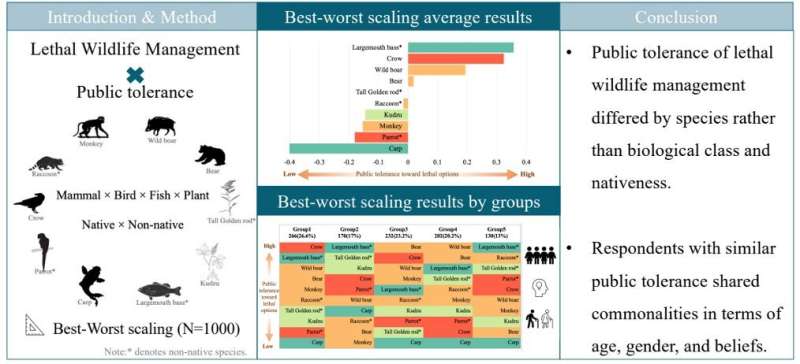This article has been reviewed according to Science X's editorial process and policies. Editors have highlighted the following attributes while ensuring the content's credibility:
fact-checked
peer-reviewed publication
trusted source
proofread
Surveying public tolerance of lethal wildlife management in Japan

Increasing human-wildlife conflict is a cause of significant concern, especially in the context of biodiversity conservation and sustainable development. Despite being controversial, lethal management of invasive wildlife species is often deemed necessary for the safety of human lives and livelihoods.
But do people accept this lethality? Researchers surveyed the public's opinion on the topic, hoping to provide data that directs efficient wildlife management practices in the future. Their findings were published in the Journal of Environmental Management on July 6, 2023.
In Japan, recent years have witnessed an expansion of wildlife distribution, abandonment of farmlands, and a decrease in human activities impacting species richness and diversity. This has led to a rise in the number of wildlife species. For instance, the wild boar population increased 252%, from 250,000 in 1989 to 880,000 in 2017. But this increase in wildlife species' populations also leads to competition for shared natural resources and damage to agriculture by wildlife, resulting in human-wildlife conflict (HWC), which then challenges sustainable development and causes social concern. This is because reducing HWC involves wildlife management, which can sometimes be lethal for the species involved.
Lethal wildlife management (LWM), though sometimes more effective in managing the damage-causing species than non-lethal methods, can often spark controversy among the public, and it is a sensitive topic. Thus, understanding public perceptions and attitudes towards LWM is important for managing the HWC issue. However, a comprehensive understanding of the acceptance of LWM is still lacking.
How tolerant are people of LWM? Are their attitudes species-specific? Do they change across different sociodemographic groups? A group of researchers set out to answer these questions, and more. The group was led by Dr. Tomoko Imoto, an associate professor at Tohoku University's Graduate School of Agricultural Science.
Speaking about the rationale of this study, Dr. Imoto, who is also the corresponding author of the paper, says, "Although studied for specific targets, variations in public tolerance based on wildlife characteristics such as biological class and nativeness to Japan were largely unexplored. We thus administered an online questionnaire survey to reveal the comparative tolerance of LWM for ten Japanese wildlife species -including mammals, birds, fish, and plants."
The survey responses were evoked using a best-worst (B-W) scaling approach, wherein respondents marked the species they would place at the two ends of a spectrum for a particular question. For example, one question asked respondents to mark the species they felt was most acceptable (i.e., the best species) or least acceptable (i.e., the worst species) to manage lethally.
The survey received 1,000 responses, and their analysis provided various insights. The acceptability of LWM among the people did, indeed, differ with species. Of the ten species studied, largemouth basses were identified as the most acceptable for LWM, followed by crows and wild boars. The most frequently chosen least acceptable species in this case was carp, followed by parrots and monkeys.
The harm that people experienced due to wildlife, too, differed, with crows, wild boars, and monkeys being found to be the most harmful animals, and parrots, carp, and kudzu being the least. Interestingly, however, the researchers found no direct correlations between harm experiences, species' biological characteristics, and nativeness. Moreover, the researchers observed that people were more accepting of LWM for those species whose negative impact and damage were more likely to be experienced in daily life.
A cluster analysis of the data further revealed that people of the same age groups, the same sex, and those who held similar beliefs regarding human-wildlife interactions also shared a common attitude or perspective towards LWM, suggesting the influence of shared sociodemographic features.
Unlike the results of previous studies, this study found that people's attitudes toward LWM were more species-specific, rather than dependent on the species' nativeness to Japan, or its larger biological class. With these sociodemographic insights, this study contributes not only to the existing body of research on the topic but also highlights the importance of public participation in wildlife management, and the importance of understanding the people's opinion and choices. This knowledge can help guide wildlife managers and policymakers in LWM.
"We hope that future studies use research framework and methodology to further understand the social aspects of wildlife management, and improve its efficiency worldwide, leading to better wildlife management policies, conservation efforts, and sustainable development and lesser HWC," concludes Dr. Imoto.
More information: Zijun Yin et al, Public tolerance of lethal wildlife management in Japan: A best–worst scaling questionnaire analysis, Journal of Environmental Management (2023). DOI: 10.1016/j.jenvman.2023.118602
Journal information: Journal of Environmental Management
Provided by Tohoku University


















